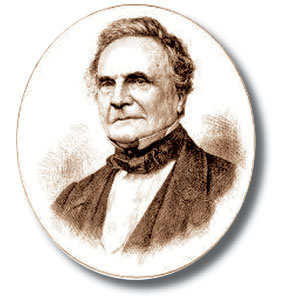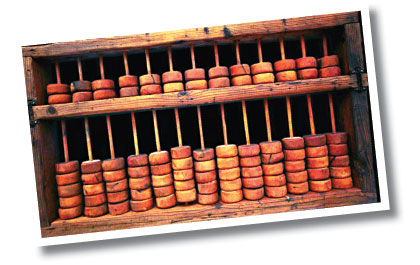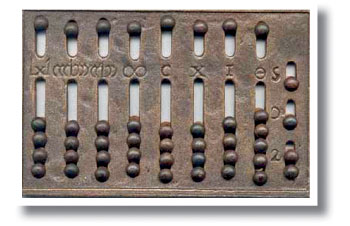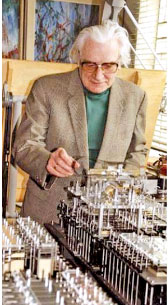The story of computers
When was the first computer invented?
 The
first mechanical computer created by Charles Babbage doesn’t really
resemble what most would consider a computer today. Therefore, this
document has been created with a listing of each of the computer firsts
starting with the Difference Engine and leading up to the types of
computers we use today. Keep in mind that early inventions that helped
lead up to the computer such as the abacus calculator and tablet
machines are not accounted for in this document. The
first mechanical computer created by Charles Babbage doesn’t really
resemble what most would consider a computer today. Therefore, this
document has been created with a listing of each of the computer firsts
starting with the Difference Engine and leading up to the types of
computers we use today. Keep in mind that early inventions that helped
lead up to the computer such as the abacus calculator and tablet
machines are not accounted for in this document.
The word “computer” was first recorded as being used in 1613 and was
originally used to describe a human who performed calculations or
computations. The definition of a computer remained the same until the
end of the 19th century when people began to realise machines never get
tired and can perform calculations much faster and more accurately than
any team of human computers ever could.
First mechanical computer or
automatic computing engine concept
In 1822 Charles Babbage began developing the Difference Engine
considered to be the first automatic computing engine that was capable
of computing several sets of numbers and making hard copies of the
results.
Later, Babbage proposed the first general mechanical computer- the
Analytical Engine. Unfortunately, this computer was also never built
while Charles Babbage’s was alive. In 1910 Henry Babbage, Charles
Babbage’s youngest son completed a portion of this machine and was able
to perform basic calculations.

First programmable computer was
originally created
by Germany’s Konrad Zuse in his parents living room in 1936 to 1938
and is considered to be the first electro-mechanical binary programmable
(modern) computer and really the first functional computer.
First concepts of what we consider a
modern computer
The Turing machine was first proposed by the Alan Turing in 1936 and
became the foundation for theories about computing and computers. The
machine was a device that printed symbols on paper tape in a manner that
emulated a person following a series of logical instructions. Without
these fundamentals, we wouldn’t have the computers we use today.
The first electric programmable
computer
The Colossus was the first electric programmable computer and was
developed by Tommy Flowers and first demonstrated in December 1943 .
The Colossus was created to help the British code breakers read
encrypted German messages.
The first digital computer
Short for Atanasoff-Berry Computer, the ABC started being developed
by Professor John Vincent Atanasoff and graduate student Cliff Berry in
1937 and continued to be developed until 1942 at the Iowa State College
(now Iowa State University).
The ABC was an electrical computer that used vacuum tubes for digital
computation including binary math and Boolean; logic and had no CPU. On
October 19, 1973 the US Federal Judge Earl R. Larson signed his decision
that the ENIAC patent by J. Presper Eckert and John Mauchly was invalid
and named Atanasoff the inventor of the electronic digital computer.
The ENIAC was invented by J. Presper Eckert and John Mauchly at the
University of Pennsylvania and began construction in 1943 ; and was not
completed until 1946 t. It occupied about 1,800 square feet and used
about 18,000 vacuum tubes, weighing almost 50 tons. Although the Judge
ruled that the ABC computer was the first digital computer, many still
consider the ENIAC to be the first digital computer because it was fully
functional.
The abacus
 It
is difficult to imagine counting without numbers, but there was a time
when written numbers did not exist. The earliest counting device was the
human hand and its fingers, the feet and toes. Then, as even larger
quantities (larger than ten human-fingers and toes could represent) were
counted, various natural items such as pebbles and twigs were used to
help keep count. It
is difficult to imagine counting without numbers, but there was a time
when written numbers did not exist. The earliest counting device was the
human hand and its fingers, the feet and toes. Then, as even larger
quantities (larger than ten human-fingers and toes could represent) were
counted, various natural items such as pebbles and twigs were used to
help keep count.

Merchants who traded goods not only needed a way to count goods they
bought and sold, but also to calculate the cost of those goods. Until
numbers were invented, counting devices were used to make everyday
calculations. The abacus is one of many counting devices invented to
help count large numbers.
The abacus and the counting board are mechanical aids used for
counting; they are not calculators in the sense we use the word today.
The person operating the abacus performs calculations in their head and
uses the abacus as a physical aid to keep track of the sums.
Konrad Zuse made world’s first program-controlled computer
 1935-1938:
Konrad Zuse builds Z1, world’s first program-controlled computer.
Despite certain mechanical engineering problems it had all the basic
ingredients of modern machines, using the binary system and today’s
standard separation of storage and control. Zuse’s 1936 patent
application (Z23139/GMD Nr. 005/021) also suggests a Von Neumann
architecture (re-invented in 1945) with program and data modifiable in
storage. 1935-1938:
Konrad Zuse builds Z1, world’s first program-controlled computer.
Despite certain mechanical engineering problems it had all the basic
ingredients of modern machines, using the binary system and today’s
standard separation of storage and control. Zuse’s 1936 patent
application (Z23139/GMD Nr. 005/021) also suggests a Von Neumann
architecture (re-invented in 1945) with program and data modifiable in
storage.
1941: Zuse completes Z3, world’s first fully functional programmable
computer.
1945: Zuse describes Plankalkuel, world’s first higher-level
programming language, containing many standard features of today’s
programming languages.
FORTRAN came almost a decade later. Zuse also used Plankalkuel to
design world’s first chess program.
1946: Zuse founds world’s first computer startup company: the
Zuse-Ingenieurbüro Hopferau. Venture capital raised through ETH Zürich
and an IBM option on Zuse’s patents.
Supercomputer and Mainframe
Supercomputer
Supercomputer is a broad term for one of the fastest computers currently
available. Supercomputers are very expensive and are employed for
specialised applications that require immense amounts of mathematical
calculations (number crunching). For example, weather forecasting
requires a supercomputer.
Mainframe computer
Mainframe was a term originally referring to the cabinet containing the
central processor unit or “main frame” of a room-filling Stone Age batch
machine. After the emergence of smaller “minicomputer” designs in the
early 1970s, the traditional big iron machines were described as
“mainframe computers” and eventually just as mainframes. Nowadays a
Mainframe is a very large and expensive computer capable of supporting
hundreds, or even thousands, of users simultaneously.
The chief difference between a supercomputer and a mainframe is that
a supercomputer channels all its power into executing a few programs as
fast as possible, whereas a mainframe uses its power to execute many
programs concurrently.
Work station
It is a type of computer used for engineering applications (CAD/CAM),
desktop publishing, software development, and other types of
applications that require a moderate amount of computing power and
relatively high quality graphics capabilities.
Personal
computer
It can be defined as a small, relatively inexpensive computer
designed for an individual user. All are based on the microprocessor
technology that enables manufacturers to put an entire CPU on one chip.
Personal computers first appeared in the late 1970s.
Today, the world of personal computers is basically divided between
Apple Macintoshes and PCs.
The principal characteristics of personal computers are that they are
single-user systems and are based on microprocessors.
Personal Computer Types
Actual personal computers can be generally classified by size and
chassis /case. Then come the portable computers that are computers small
enough to carry. Portable computers include notebook and subnotebook
computers, hand-held computers, palmtops, and PDAs.
*?Tower model
The term refers to a computer in which the power supply, motherboard,
and mass storage devices are stacked on top of each other in a cabinet.
This is in contrast to desktop models, in which these components are
housed in a more compact box.
*Desktop model
A computer designed to fit comfortably on top of a desk, typically
with the monitor sitting on top of the computer. Desktop model computers
are broad and low, whereas tower model computers are narrow and tall.
Because of their shape, desktop model computers are generally limited
to three internal mass storage devices. Desktop models designed to be
very small are sometimes referred to as slimline models.
*Notebook computer
An extremely lightweight personal computer. Notebook computers
typically weigh less .
*Palmtop
A small computer that literally fits in your palm. Compared to
full-size computers, palmtops are severely limited, but they are
practical for certain functions such as phone books and calendars.
Palmtops that use a pen rather than a keyboard for input are often
called hand-held computers or PDAs. Because of their small size, most
palmtop computers do not include disk drives.
*PDA
Short for personal digital assistant, a hand-held device that
combines computing, telephone/fax, and networking features. A typical
PDA can function as a cellular phone, fax sender, and personal organiser.
Unlike portable computers, most PDAs are pen-based, using a stylus
rather than a keyboard for input.
This means that they also incorporate handwriting recognition
features. To date,PDAs have had only modest success in the marketplace,
due to their highprice tags and limited applications. However, many
experts believe that PDAs will eventually become common gadgets. |

